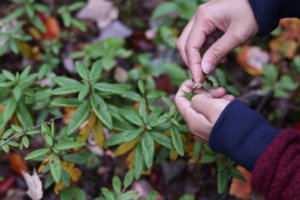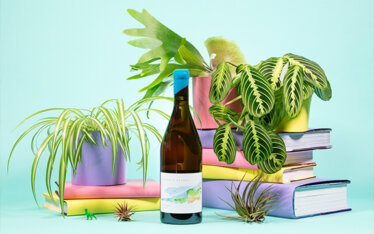I first was introduced to Labrador Tea in 2017 during From The Wild bush camp in the boreal forest of Edmonton. Ever since that encounter I’ve been really intrigue by this beautiful little bush tea that’s found all over Canada. Its fancy Latin name is Rhododendron Groenlandicum but I like to refer to it as ‘sleepy time tea’.

As we set off on the standard looking flat trail in PEI, we didn’t make it a kilometre before wandering off-trail into the darkness. It really is when you start adventuring into the woods is the impact of Dorian is revealed with silent fallen trees still able to tell a story.
Looking down as we step, boom – Labrador Tea forever. It’s safe to say that this shrub loves damp, shaded moss-y areas (which is my favourite type of woods). The plant itself is stunning, which makes the identification process easier – long, oval shaped brilliant green leaves with a burnt orange back that’s a bit fuzzy. Having harvesting them in Alberta and now on the east coast, it was interesting to see how much longer the leaves were here. Taste wise its mild, but aromatic – kind of like if green tea and evergreen had a baby with baking spices with this cinnamon vibe. But, for some it also has this mushroom-y thing going on.


When I forage, I like to be mindful about the fact we share this ecosystem with other things, so I’ve gotten into the habit of leaving enough behind. That’s especially the case because it’s a slow growing plant – pick only a few leaves from each plant, instead of harvesting everything from the whole plant. Think of it as regenerative farming in a way or having that mindset. Once harvested, just spread on a baking sheet and dry in the sun or in an oven with the pilot light on, then store in an airtight container until you’d like to play.

I’m always fascinated with the connection to the land that the First Nations and other indigenous peoples have. Our First Nations would use Labrador Tea for its medicinal properties – it’s pretty much an inflammatory thing helping with burns, rheumatism, arthritis and asthma. According to ‘The Google’, Labrador Tea is high in Vitamin C and for a long time was used to prevent scurvy. Food is medicine and all. It’s also important to mention that you should avoid it if you’re pregnant and like most wild foods, it’s always a good idea to do your own research and use conscientiously.
Uses:
- Take 5 to 10 leaves, add to a pot with water and then bring to a boil, turn down to a simmer for about 10 to 15 minutes. You want the water to turn more of a reddish brown colour.
- Add to poaching liquids for a bit of a woodsy feel.
- The First Nations would add Labrador Tea to braise meats, but you can do the same to vegetables, grains or wild rice, too.

Judging by the barbed wire as we left the patch, we’re also guessing the plant likes private property, but that can’t be confirmed. I’m excited to play with this wild food more and more within my cooking, starting with a forest floor inspired poaching liquid for local pears.
If you haven’t figured this out yet, I’m a pretty curious human with lots of random information. So, you can expect more about the wondrous world of wild foods in the next little bit.
Speak soon,
Aman



